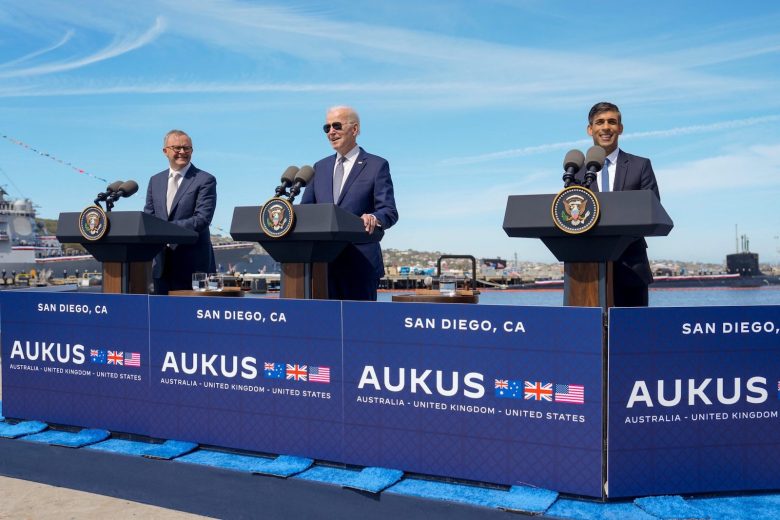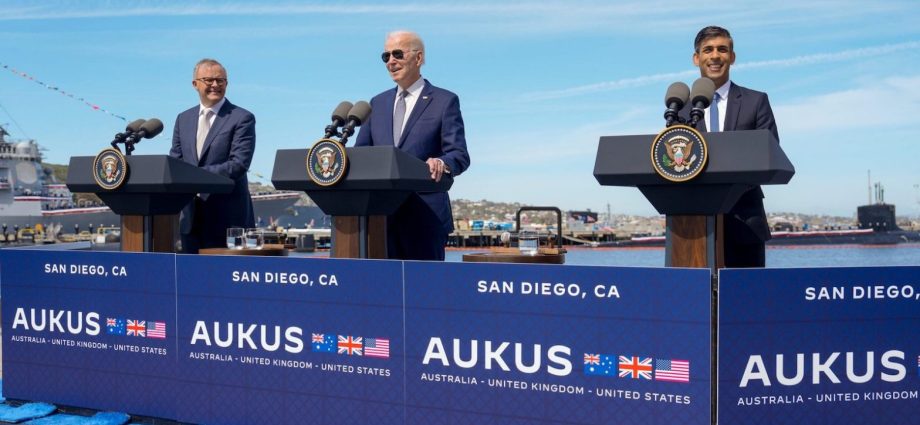A legal foundation for AUKUS is the freedom of navigation. This raises some fundamental issues under the international law of the sea which have mostly been sidestepped in AUKUS debates.
For example, where will Australia’s nuclear-powered AUKUS submarines be able to sail? Will there be limitations on their navigation? What does the international law of the sea say about submarine navigation?
These issues have been highlighted in the debate about AUKUS in Southeast Asia since the deal between Australia, the United Kingdom and the United States was announced in September 2021.
Indonesia and Malaysia, for example, have raised concerns over the possible presence of Australian nuclear-powered submarines in their waters. This goes directly to the issue of how the freedom of navigation can be exercised by submarines under the law of the sea, particularly nuclear-powered submarines.
It is helpful to consider the waters that the AUKUS submarines will principally operate in to frame the legal issues. The submarines will most probably be based either at HMAS Sterling in Western Australia or somewhere along Australia’s eastern seaboard.
When on operations the submarines would move from their base beyond the 12 nautical mile Australian territorial sea and into the 200 nautical mile Australian exclusive economic zone (EEZ). Within those waters, the submarines would be exercising navigational rights as Australian-flagged warships.
Beyond the Australian EEZ are the high seas of the Indian Ocean and Pacific Ocean where the submarines may undertake patrols. The freedom of navigation of the high seas is a fundamental principle of the law of the sea and of international law. There is no legal impediment to the submarines being able to navigate on the high seas.
But navigation becomes more sensitive and controlled in other waters and this is where the law of the sea becomes prominent.
The 1982 UN Convention on the Law of the Sea (UNCLOS) — the “Constitution of the Oceans” — is the primary treaty governing the oceans. Indonesia, Malaysia, the Philippines, Singapore and Thailand and the key states in the Southwest Pacific are all parties to UNCLOS.
While the United States is not a party to UNCLOS, it has consistently argued that the convention represents customary international law. That view is generally not contested with respect to the key provisions dealing with navigation.
UNCLOS freedom of navigation entitlements were critical to the negotiation of the convention and enabled coastal states to claim a 12-nautical mile territorial sea and 200-nautical mile EEZ.
The entitlements were also essential to the eventual recognition of the archipelagic state concept — a key goal for some island states — and one which Indonesia and the Philippines advanced during UNCLOS negotiations.

The major maritime powers would not have accepted expanded maritime zones and recognition of the status of archipelagic states without clear legal entitlements of the freedom of navigation within certain waters for merchant ships and warships, including submarines.
UNCLOS recognizes the right of innocent passage for the ships of all states within the territorial sea (Article 17). Submarines are expressly included within those entitlements, subject to navigating on the surface and showing their flag (Article 20).
But territorial sea navigation by AUKUS submarines is not central to their defense and strategic capability. More important is the ability of the submarines to pass through international straits, especially archipelagic waters.
The Torres Strait and the Straits of Malacca and Singapore surround Australia. But these straits are shallow, congested and navigationally challenging and are less attractive to submarines. Transit passage is the UNCLOS navigational right that applies within international straits (Article 38).
Submarines should pass through international straits without delay and refrain from threats or the use of force and activities other than those consistent with “normal modes of continuous and expeditious transit” (Article 39).
This means that submarines can pass submerged through an international strait where it is safe to do so. Littoral strait states have limited capacity to regulate the passage of such vessels which also enjoy sovereign immunity.
The regime of archipelagic sea lanes passage (ASLP) within recognized archipelagic states (Article 53) — of which there are 22 including Indonesia, Papua New Guinea and the Philippines — is also significant to AUKUS. The right of ASLP modifies transit passage through archipelagic waters — a body of water comprising multiple interconnected straits.
Within designated archipelagic sea lanes or normally used navigation routes, ships can pass through archipelagic waters — like an international maritime highway — from an entry point to an exit point.
Submarines can pass through archipelagos submerged and archipelagic state have very limited capacity to regulate submarine navigation conducted consistently with UNCLOS.
The capacity of AUKUS submarines to sail from Australian waters through the straits and archipelagos of Southeast Asia to the South China Sea and East Asia rests on the freedom of navigation recognized in UNCLOS.
Freedom of navigation is an entitlement that the US Navy — both its submarines and its other nuclear-powered and nuclear-armed warships — have been exercising for decades. Submarines engaged in transit passage or ALSP cannot have their navigation hampered. This right of navigation, if conducted consistently with UNCLOS, cannot be suspended.
Attempts to single out Australia’s future AUKUS nuclear-powered submarines for exceptional navigational regulation are not consistent with the law of the sea.
Donald R Rothwell is Professor of International Law at the ANU College of Law, The Australian National University.
This article was originally published by East Asia Forum and is republished under a Creative Commons license.

